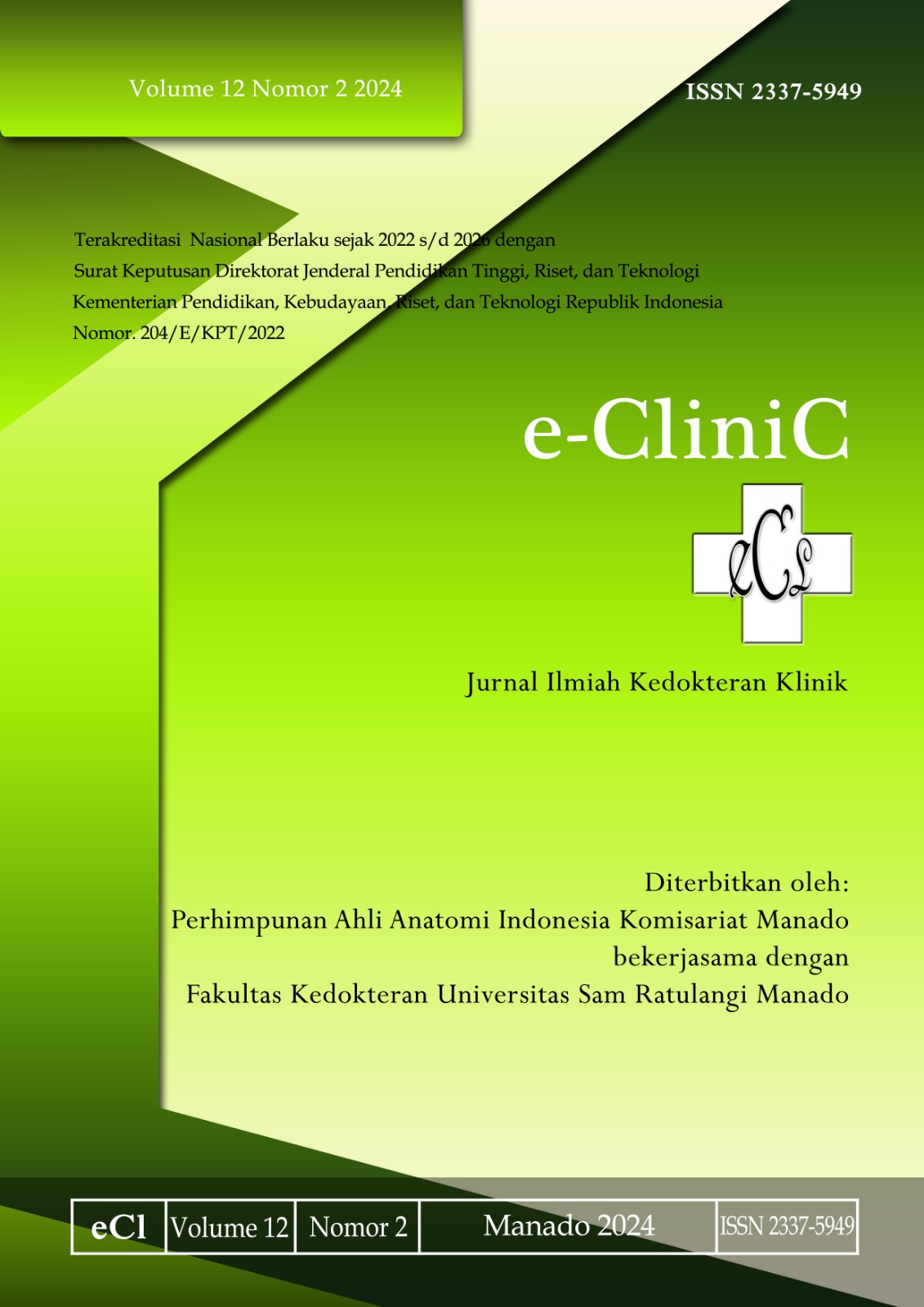Primary Closure of Gastric Perforation Using Seromuscular Omentum Insertion: A Case Report
DOI:
https://doi.org/10.35790/ecl.v12i2.46850Abstract
Abstract: Gastric perforation is the most common disease and a surgical emergency with high morbidity and mortality; therefore, early and precise management is needed. However, no consensus has been accepted regarding the best surgical treatment for gastric perforation closure so far. Although surgery methods are varied, laparotomy, and omental patch repair are still the gold standard. The risk of leakage after primary closure accompanied by omentopexy is still common, resulting high morbidity and mortality. This study aimed to discuss about the modified method by means of primary closure with seromuscular omentum insertion in a gastric perforation case. We modified the usual method using primary closure with seromuscular omentum insertion, to get the best way for perforation closure and reduced risk of leakage. After a week of surgical perforation closure, the patient was discharged and further observation resulted in no leakage. In conclusion, modified method by using primary closure with seromuscular omentum insertion in gastric perforation has good result without any leakage and recurrence.
Keywords: gastric perforation; omentum; primary closure
References
Odisho T, Shahait AA, Sharza J, Ali AA. (2022). Outcomes of laparoscopic modified Cellan-Jones repair versus open repair for perforated peptic ulcer at a community hospital. Surgical Endoscopy. 2022;37(1):715-221. Doi:10.1007/s00464-022-09306-7
Leeman MF, Skouras C, Paterson-Brown S. The management of perforated gastric ulcers. Int J Surg. 2013;11(4):322-4. Doi: 10.1016/j.ijsu.2013.02.010
Satapathy MC, Dash D, Panda C. Modified Grahams’ omentopexy in acute perforation of first part of duodenum; A tertiary level experience in South India. Saudi Surgical Journal. 2013;1(2):33. Doi: https://doi.org/10.4103/2320-3846.125032
Kidwai R, Ansari MA. Graham patch versus modified graham patch in the management of perforated duodenal ulcer. Journal of Nepalgunj Medical College. 2015;13(1):28-31. Doi: https://doi.org/ 10.3126/ jngmc.v13i1.16409
Porzionato A, Sfriso MM, Macchi V, Rambaldo A, Lago G, Lancerotto L, Vindigni V, et al. Decellularized omentum as novel biologic scaffold for reconstructive surgery and regenerative medicine. Eur J Histochem. 2013;57(1):e4. Doi: 10.4081/ejh.2013.e4
Ellatif MEA, Salama AF, Elezaby AF, El-Kaffas HF, Hassan A, Magdy A, et al. Laparoscopic repair of perforated peptic ulcer: patch versus simple closure. Int J Surg. 2013;11(9):948-51. Doi: 10.1016/j.ijsu.2013.06.014
Zhu C, Badach J, Lin A, Atabek U, Spitz FR, Young KH, et al. Omental patch versus gastric resection fir perforated gastric ulcer: Systematic review and meta-analysis for an unresolved debate. Am J Surg. 2021;221(5):935-41. Doi: https://doi.org/10.1016/j.amjsurg.2020.07.039
Khalifa MS, Mohammed HA, Elhefny AMM. Management of perforated large/giant peptic ulcers: a comparative prospective study between omental plug, duodenal exclusion, and jejunal serosal patch. Egypt J Surg. 2021;40(2):663-72. Doi: 10.4103/ejs.ejs_60_21
Di Nicola V. Omentum a powerful biological source in regenerative surgery. Regen Ther. 2019;11(1):182-91. Doi: https://doi.org/10.1016/j.reth.2019.07.008
Ayyaz M, Shafiq A, Butt UI, Khan WH, Umar M, Abaid A. Outcome of laparoscopic repair for perforated peptic ulcers in a resource-limited setting monitoring. Cureus. 2022;14(4):e24159. Doi: 10.7759/cureus.24159
Jamal MH, Karam A, Alsharqawi N, Buhamra A, AlBader I, Al-Abbad J, et al. Laparoscopy in acute care surgery: repair of perforated duodenal ulcer. Med Princ Pract. 2019;28(5):442–8. Doi: 10.1159/000500107
Ishaq A, Noureen S, Khan MJ, Awa AA, Ghazi E, Mustafa R. Large posterior of duodenal ulcer: a rare surgical emergency. Int J Case Rep. 2018;2(3):11.
Weledji EP. An Overview of Gastroduodenal Perforation. Frontiers in Surgery. 2020;7:573901. Doi: https://doi.org/10.3389/fsurg.2020.573901
Sacko O, Diallo S, Soumaré L, Camara M, Koumaré S, Sissoko M, et al. Perforations of Gastro-Duodenal Ulcers in the Surgery Department “A” at the University Hospital Point G Bamako. Surgical Science. 2019;10:265-70. Doi: 10.4236/ss.2019.108028
Downloads
Published
How to Cite
Issue
Section
License
Copyright (c) 2024 Ferry Kalitouw, Billy Salem, Brian Sugito

This work is licensed under a Creative Commons Attribution-NonCommercial 4.0 International License.
COPYRIGHT
Authors who publish with this journal agree to the following terms:
Authors hold their copyright and grant this journal the privilege of first publication, with the work simultaneously licensed under a Creative Commons Attribution License that permits others to impart the work with an acknowledgment of the work's origin and initial publication by this journal.
Authors can enter into separate or additional contractual arrangements for the non-exclusive distribution of the journal's published version of the work (for example, post it to an institutional repository or publish it in a book), with an acknowledgment of its underlying publication in this journal.
Authors are permitted and encouraged to post their work online (for example, in institutional repositories or on their website) as it can lead to productive exchanges, as well as earlier and greater citation of the published work (See The Effect of Open Access).







